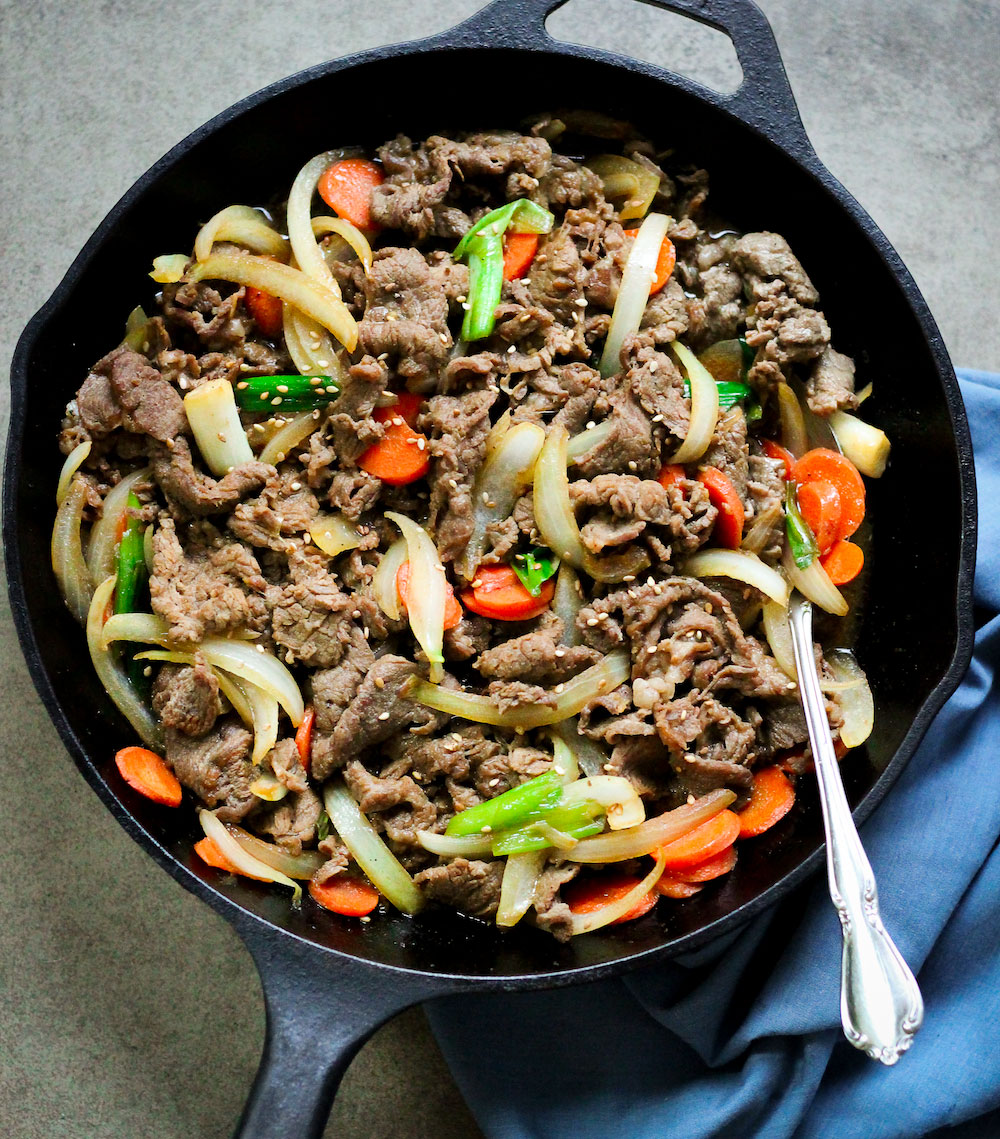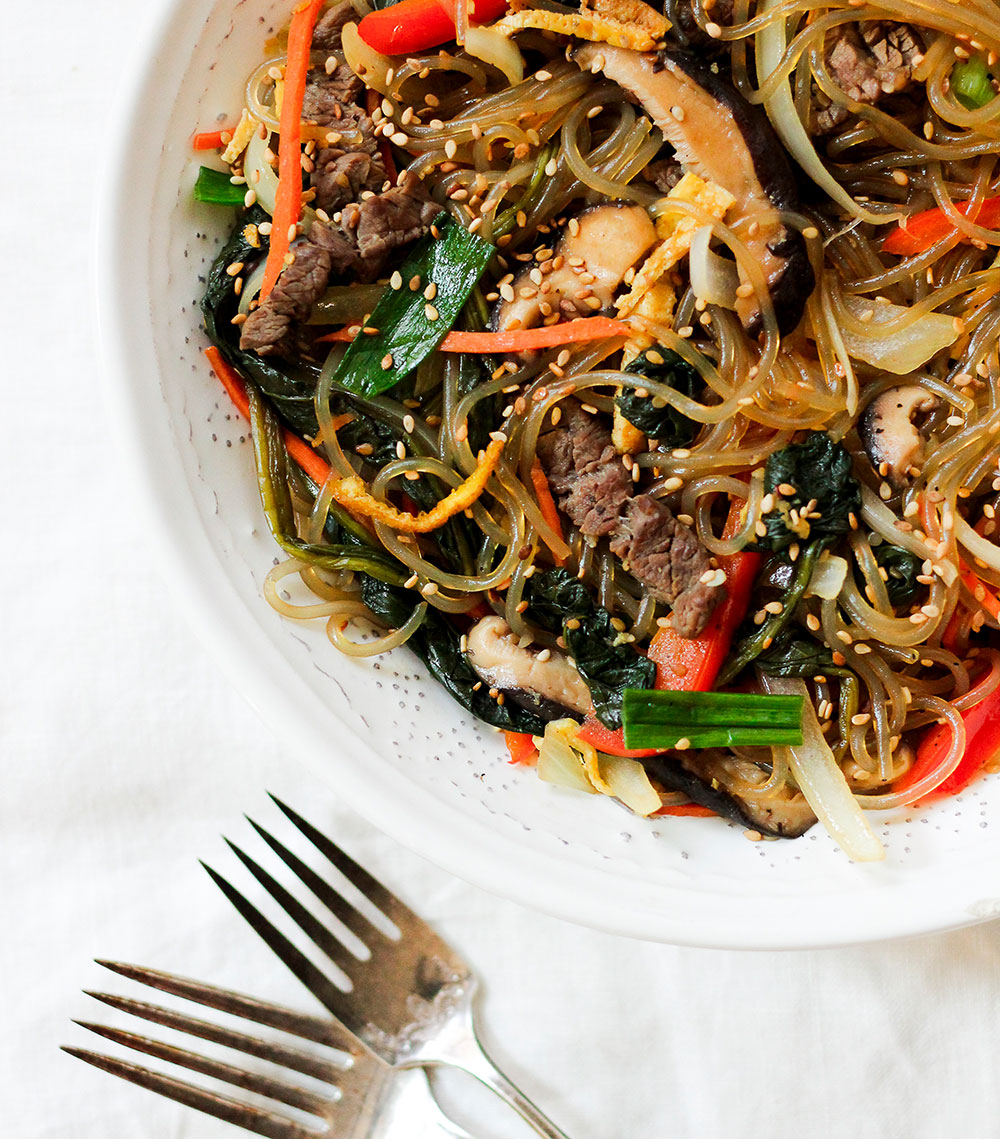Paleo Bulgogi (Korean BBQ Beef)
This mouthwatering recipe for bulgogi (Korean BBQ beef) is a preview inside my dear friend Jean Choi’s debut cookbook, Korean Paleo. I have absolutely LOVED immersing myself in learning traditional Korean cooking with this book. The recipes are authentic, easy to follow, and incredibly delicious!
If you don’t already know Jean, she blogs at What Greatgrandma Ate (isn’t that a great nod to ancestral eating?) and she is also a part of my Beautycounter team. If you don’t already follow her on Instagram make sure you go do that now!
Shopping For Korean Ingredients
I have to admit that I was slightly intimidated at first to source some of the key ingredients used throughout the book that are staples of Korean cuisine, BUT Jean does an excellent job of explaining how to find the best options, where to look in the store, etc.
There is an entire chapter in the back called “stocking up your Korean paleo kitchen” that is your guide for ensuring you get the good stuff! She also published a comprehensive blog post that goes even more in-depth and also provides links to specific brands she prefers - this is SO HELPFUL! Read it here: Essential Ingredients For Korean Paleo Cooking.
The international markets here in Memphis often combine Latin American and Asian ingredients, and while I find it a breeze to navigate the Latin aisles (I mean, c’mon, I wrote Latin American Paleo Cooking!) I admit I hadn’t spend much time on the Asian aisles before getting Korean Paleo.
The dried anchovies and saewoojeot (salted fermented tiny shrimp) were the two ingredients that made me feel a bit uncertain (TINY EYEBALLS o.O) but I am glad I got both and enjoy the robust depth of flavor they add to dishes!
Types of Recipes inside Korean Paleo
Curious if the recipes will suit your specific dietary needs? Here is a quick breakdown of how many recipes fit each category:
Egg-free: 53
Nightshade-free: 27
Nut-free: 70
Whole30: 27
AIP-optional: 17
Keto: 21
There are 8 recipe chapters in the cookbook:
Cooking with Bap (Rice Dishes)
BBQs and So Much More (Protein Dishes)
Piping Hot Soups and Stews
Gooksoo Time! (Noodles)
Not-Your-Typical Pancakes (includes crispy and delicious savory pancakes with various vegetable and/or protein fillings. If you like these try my NYC-style Scallion Pancakes recipe, the original Paleo version!)
More Banchan Please? (Side DIshes)
Best of Both Worlds (Fusion)
Something Sweet to Balance Out the Spicy
My favorite dishes from Korean Paleo
I started my dive into Korean Paleo by making a batch of gochujang, which is a thick, sticky red chile paste that is one of the staple base ingredients in much of Korean cooking. It’s similar to sofrito in Puerto Rican cuisine.
Paleo Gochujang (Korean Red Chili Paste)
See how beautiful that Paleo gochujang is? Store-bought versions are highly processed and every single one of them I saw contained gluten, soy, HFCS, and other ingredients I avoid. The base of the paste that Jean came up with to make it Paleo is ingenious, and to preserve it longer you can ferment it on the counter before storing in the fridge! I have REALLY enjoyed using gochujang both in the recipes as written, and also in some made up dishes I’ve tried. It has a nice depth of flavor and is fairly mild, not hot.
Next I made the Kongnamul Guk, or bean sprout soup with a big bowl of Miyeok Muchim (seaweed salad). The broth of this soup is made using those dried anchovies and it is SO GOOD!
My cats were also very interested in what I was up to in the kitchen while I was making these dishes since the kitchen smelled like the ocean. I also learned that dried seaweed is a great cat treat haha. They BEGGED and BEGGED for it!
Paleo Kongnamul Guk (Korean Mung Bean Sprout Soup)
Paleo Miyeok Muchim (Korean Seaweed-Salad)
Next I tried my hand at the breakfast dishes: Gyeran Jjim (steamed egg pot) and Gyeranmari (rolled omelet). Both were soooo delicious and a great way to mix things up from my normal over-medium fried eggs. The pillowy soft texture of the steamed egg pot was a surprise!
Gyeran Jjim (Steamed Egg Pot)
Paleo Gyeranmari (Korean Rolled Omelet)
Next up: Yangnyeom Tongdak, sweet and spicy crispy wings. I thought I had found the last recipe for wings I’d ever need with my Paleo version of the Brazilian classic frango a passarinho. And I still think it’s the best recipe ever for dry yet crispy and crazy flavorful wings. But for wet wings? Nothing beats these. OMG.
The sauce has that amazing gochujang at the base, blended with things like honey and ginger to make the best damn wing sauce I’ve ever had. Even my husband Andy loved these, and he does NOT like wet messy wings.
Paleo Yangnyeom Tongdak (Korean Sweet & Spicy Crispy Chicken-Wings)
Japchae was next. Y’all, you MUST make this dish! Many in the Paleo and especially AIP communities will already be familiar with the sweet potato starch noodles (called dangmyeon, sometimes labeled as glass noodles) that are used as the traditional base of this dish. I have to admit that I was guilty of never knowing what those noodles were SUPPOSED to be used for, I didn’t even realize they were Korean, I just knew they are a great Paleo- and AIP-friendly noodle. So I was so happy to learn the traditional use for them thanks to this recipe.
There are a lot of moving parts to this dish, but now that I’ve made it once I see how they all come together for the final dish and it will be MUCH faster and easier from now on. This is part of our monthly meal rotation now!
Paleo Japchae (Korean Stir-Fried Sweet Potato Noodles)
And last but definitely not least, BULGOGI! And I am so thrilled to be able to share this recipe with you. I do hope that you purchase a copy of the book so that you can make all the other amazing dishes I gushed about above. I think once you taste this dish you’ll be sold!
The key to bulgogi is the marinade, which features a unique blend of ingredients including Korean pear! I was so surprised at how this dish tasted thanks to that special ingredient. Naturally sweet + savory is such a delicious and refreshing combo.
I used a bavette since that was the closest thing to a sirloin steak they at at the Curb Market 901 (my favorite grocery store for buying locally raised pastured meats and naturally grown vegetables). The bavette actually is part of the sirloin (the sirloin tip). It works beautifully in stir fries!
Paleo Bulgogi (Korean BBQ Beef)
Bulgogi (BBQ Beef) from Korean Paleo Cookbook
Published 01/11/2019

From Jean: Probably one of the most popular barbecue meats, bulgogi is a traditional Korean dish known for its addictive sweet and salty combo. The trick is to slice the meat paper thin so it can soak up as much of the delicious marinade as possible. You can probably find these meats pre-sliced at a local Korean grocery store, but if not, you can easily do this at home with the simple trick of freezing the meat slightly first.
Ingredients
- 1 lb (454 g) beef sirloin (or any other tender cuts that are well marbled)
- 6 tbsp (90 ml) coconut aminos
- 1⁄2 medium pear (preferably Korean pear), cut into chunks
- 2 tsp (10 ml) sesame oil
- 1" (2.5-cm) piece fresh ginger
- 3 cloves garlic, peeled
- 2 tbsp (30 ml) apple cider vinegar
- 1⁄4 tsp ground black pepper
- 1 medium onion, sliced
- 2 green onions, sliced in 1
- 1 carrot, sliced
- 1 tbsp (15 ml) cooking oil
- 1 tbsp (8 g) toasted sesame seeds, for serving
Instructions
- Place the beef in the freezer for 30 minutes, then take it out and slice it thinly, about 1⁄16 to 1⁄8 inch (1 to 3 mm) thick.
- Place the coconut aminos, pear, sesame oil, ginger, garlic, apple cider vinegar and black pepper in a high-powered blender. Blend well until liquified.
- Combine the sliced beef and the marinade in a large bowl. Toss and massage together with your hand until all the beef slices are covered in the marinade. Cover and marinate in the refrigerator for 1 hour to overnight.
- When you are ready to cook the beef, remove it from the marinade, shaking off the excess drippings. Slice the onion, green onions and carrot, and combine the vegetables with the meat.
- Heat the cooking oil over high heat in a large skillet. Working in batches so you don’t overcrowd the pan, add the beef and vegetables and stir-fry together until the meat is browned and cooked through, about 5 to 7 minutes.
- Sprinkle with toasted sesame seeds before serving. You can eat Bulgogi on its own or in a lettuce wrap served with Umma’s Ssamjang (Dipping Sauce).
Yield: 4 servings
Prep Time: 00 hrs. 30 mins.Cook time: 00 hrs. 10 mins.
Total time: 40 mins.
Nutrition
- Calories: 332












